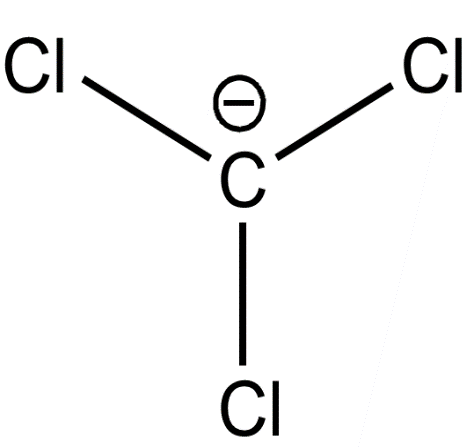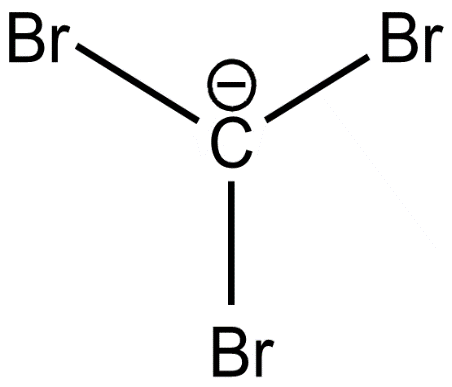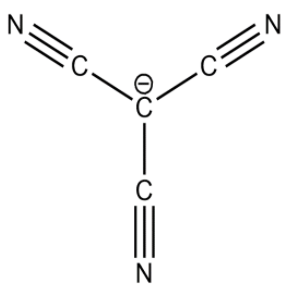
Which among the following is the strongest acid $?$
A. $CH{I_3}$
B. $CHC{l_3}$
C. $CHB{r_3}$
D. $CH{(CN)_3}$
Answer
499.5k+ views
Hint: Acids are substances that can release $[{H^ + }]$ in solution. The strength of acids are measured by their pKa value. Stronger the acid, lesser will be its pKa value. Strong acids have a stable conjugate base after releasing their $[{H^ + }]$ . On releasing the proton, they attain a negative charge.
Complete answer:
We know that acids are proton donors which on releasing the protons forms a conjugate base. A conjugate base is a potent proton acceptor. The conjugate bases of above species are given below.
(a)

(b)

(c)

(d)

On releasing $[{H^ + }]$ carbanions are formed. The stability of carbanions of trihalides are determined by inductive and delocalisation of electrons. Here, all the above carbanions have the $ - I$ effect. In addition to it, the vacant d orbitals of halides form back bonding with carbon p orbitals.
It is more effective and stronger in Cl. It forms $2p\pi - 3d\pi $ overlap and delocalisation of electrons lowers the energy and increases the stability. In the cases of Br and I the d orbitals are very large and therefore effective back bonding does not take place. The conjugate base of trichloromethane or chloroform is more stable and therefore more acidic.
In the case of tricyanomethane, the carbanion is stabilised by metamerism in addition to $ - I$ effect.
Resonating structures are formed between carbon and nitrogen and negative charge lies on nitrogen which gives a stable structure. Hence, the delocalisation of negative charge gives rise to the most stable conjugate base.
Therefore, $(D)\,\,CH{(CN)_3}$ is the strongest acid .
Note:
In the case of halides, $CH{F_3}$ may seem to be the strongest acid, but it is not. F is the most electronegative element and therefore has more $ - I$ effect. It can pull the electron density and makes the release of $[{H^ + }]$ easier. But it does not have a vacant d orbital. Therefore, effective delocalisation of electrons cannot happen in the conjugate base making it less stable. It is a weak acid.
Complete answer:
We know that acids are proton donors which on releasing the protons forms a conjugate base. A conjugate base is a potent proton acceptor. The conjugate bases of above species are given below.
(a)

(b)

(c)

(d)

On releasing $[{H^ + }]$ carbanions are formed. The stability of carbanions of trihalides are determined by inductive and delocalisation of electrons. Here, all the above carbanions have the $ - I$ effect. In addition to it, the vacant d orbitals of halides form back bonding with carbon p orbitals.
It is more effective and stronger in Cl. It forms $2p\pi - 3d\pi $ overlap and delocalisation of electrons lowers the energy and increases the stability. In the cases of Br and I the d orbitals are very large and therefore effective back bonding does not take place. The conjugate base of trichloromethane or chloroform is more stable and therefore more acidic.
In the case of tricyanomethane, the carbanion is stabilised by metamerism in addition to $ - I$ effect.
Resonating structures are formed between carbon and nitrogen and negative charge lies on nitrogen which gives a stable structure. Hence, the delocalisation of negative charge gives rise to the most stable conjugate base.
Therefore, $(D)\,\,CH{(CN)_3}$ is the strongest acid .
Note:
In the case of halides, $CH{F_3}$ may seem to be the strongest acid, but it is not. F is the most electronegative element and therefore has more $ - I$ effect. It can pull the electron density and makes the release of $[{H^ + }]$ easier. But it does not have a vacant d orbital. Therefore, effective delocalisation of electrons cannot happen in the conjugate base making it less stable. It is a weak acid.
Recently Updated Pages
Master Class 12 Business Studies: Engaging Questions & Answers for Success

Master Class 12 Economics: Engaging Questions & Answers for Success

Master Class 12 English: Engaging Questions & Answers for Success

Master Class 12 Maths: Engaging Questions & Answers for Success

Master Class 12 Social Science: Engaging Questions & Answers for Success

Master Class 12 Chemistry: Engaging Questions & Answers for Success

Trending doubts
What is meant by exothermic and endothermic reactions class 11 chemistry CBSE

Which animal has three hearts class 11 biology CBSE

10 examples of friction in our daily life

One Metric ton is equal to kg A 10000 B 1000 C 100 class 11 physics CBSE

1 Quintal is equal to a 110 kg b 10 kg c 100kg d 1000 class 11 physics CBSE

Difference Between Prokaryotic Cells and Eukaryotic Cells




